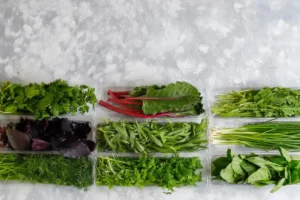Ah, spinach dip! That creamy, delightful concoction that’s a hit at any gathering, big or small. But here’s a pickle – how long does this favorite appetizer stay fresh in the fridge? Well, folks, buckle up because we’re diving deep into the world of spinach dip, from its ingredients and types to storage tips and safety guidelines. Our goal? To keep your dip delicious and safe, preventing any party fouls or food mishaps. So, let’s get the ball rolling and spread the knowledge on keeping that spinach dip in tip-top shape.
Introduction
Imagine this: you’ve whipped up a bowl of luscious spinach dip, and it’s been the star of the show at your little soirée. Fast forward to the next day, and you’re left wondering, “How long will this culinary masterpiece last in the fridge?” It’s a question as old as time, or at least as old as refrigerators.
Spinach dip isn’t just a blend of ingredients; it’s a symphony of flavors, bringing together spinach, dairy, and seasonings in a harmonious mix. But, like all good things, it has a shelf life. Understanding this not only ensures you’re serving up freshness but also keeps you on the right side of food safety.
Why, you ask? Well, for starters, no one wants to be remembered as the host who served the dip that took a dip in quality. Plus, with the varying ingredients that can go into spinach dip, including dairy products with their own set of storage needs, it’s a bit of a balancing act to keep it fresh and safe for consumption.
And here’s the kicker: not all spinach dips are created equal. The longevity of your dip can swing widely based on whether it’s homemade or store-bought, the freshness of the ingredients, and how it’s been stored. So, whether you’re a dip-making veteran or trying your hand at it for the first time, stick around. We’re about to lay down some serious knowledge on keeping your spinach dip delightful days after the party has ended.
So, without further ado, let’s dip into the essence of spinach dip preservation. After all, the more you know, the longer you can savor that deliciousness. And who wouldn’t want that?
Components and Types of Spinach Dip

Spinach dip, the heart and soul of many a gathering, owes its delectable nature to a blend of ingredients that sing in harmony. At its core, you’ll often find fresh spinach, cream cheese, sour cream, mayonnaise, garlic, and onions. Some chefs like to throw in a curveball with additional veggies or a secret seasoning, turning a simple dip into a conversation starter.
Ingredients in Spinach Dip
Let’s talk ingredients, shall we? The classic recipe pulls together the rich creaminess of cream cheese with the tang of sour cream and the subtle bite of mayonnaise, creating a base that’s both smooth and packed with flavor. Fresh spinach, wilted down to a fraction of its original volume, adds a pop of color and a hint of earthiness. Garlic and onions? They’re the dynamic duo that infuses the dip with a depth of flavor, making it hard to resist going back for just one more scoop.
But, oh, the variations! From the addition of artichokes to swapping in Greek yogurt for a lighter fare, the possibilities are endless. Each choice tweaks the taste and texture, offering a new experience with every batch.
Homemade vs. Store-Bought Spinach Dip
Now, here’s where things get interesting. Homemade spinach dip has a charm all its own, often fresher and customizable to your heart’s desire. But don’t sleep on the store-bought varieties; they come with the convenience of a grab-and-go option, with some even boasting a longer shelf life thanks to the preservatives within.
The key difference? Shelf life. Homemade versions, while boasting the badge of personal touch and possibly fresher ingredients, typically have a shorter stay in the fridge. On the flip side, store-bought dips, with their added preservatives, can linger a little longer, waiting patiently for your next snack attack.
So, whether you’re a wizard in the kitchen, conjuring up your dip from scratch, or you prefer the ease of a pre-made delight, understanding the nature of what goes into your spinach dip can make all the difference in how long you can enjoy it safely. And remember, the fresher the ingredients, the more delightful the dip. So, choose wisely, mix heartily, and let’s keep the dip delicious all week long.
Factors Affecting Shelf Life
When it comes to the shelf life of our beloved spinach dip, several key factors come into play, turning the simple act of storing it into something akin to an art form. Let’s peel back the layers and dive into what affects how long you can keep enjoying that dip without a worry in the world.
Ingredients and Preparation Method
First and foremost, the ingredients themselves hold sway over the longevity of your dip. Fresh ingredients, while elevating the taste, often mean a shorter shelf life due to their natural propensity to spoil quicker. The presence of dairy products like sour cream and mayonnaise, both beloved for their creamy texture, require careful handling as they can be a playground for unwanted bacteria if not stored correctly.
The preparation method also plays its part. A homemade concoction, lovingly prepared in your kitchen, lacks the preservatives that many store-bought options come packed with, making them a tad more susceptible to going off quicker. But hey, what’s a few days less in the fridge compared to the unbeatable taste of homemade goodness?
Storage Conditions
The plot thickens when we consider storage conditions. Here’s where things get chilly—literally. The temperature of your refrigerator, the type of container you use, and how soon you get that dip chilled after making it can all extend or reduce its shelf life. A pro tip? Keep your fridge temperature below 40°F (4°C) and store the dip in an airtight container to ward off any spoilage spoilers.
Guidelines for Storing Spinach Dip

So, you’ve crafted the perfect spinach dip, and now you want to keep it as fresh as possible for as long as possible. Fear not, for here come the golden rules of spinach dip storage, a guide to dip longevity.
Proper Storage in the Fridge
To keep that dip delightful, ensure it cools off before hitting the fridge. Hot food can raise your fridge’s temperature, putting other foods at risk. Once cool, an airtight container is your dip’s best friend, keeping unwanted air and bacteria out and freshness in. And remember, the coldest part of your fridge is its sweet spot.
Freezing Spinach Dip
Venturing into the frosty realms, freezing spinach dip is a viable option to extend its edible expedition. However, bear in mind that dairy-based dips might separate or become grainy once thawed. If you decide to freeze, do so in portion-sized containers—you’ll thank yourself later when you can defrost just the right amount for a snack.
Recognizing Spoilage
Our journey wouldn’t be complete without knowing how to spot a dip disaster. A sour smell, visible mold, or an off taste are clear distress signals. If your dip starts sending these signals, it’s time to bid it farewell. Better safe than sorry, as they say.
Navigating the shelf life of spinach dip might seem daunting at first, but armed with these insights, you’re more than ready to keep that dip delicious for days (or even longer). Stay tuned for the next chapter in our dip saga, where we’ll dive into tips for maximizing shelf life and ensuring your spinach dip remains a crowd-pleaser long after the party’s over.
Maximizing the Shelf Life and Safety of Spinach Dip

Ensuring your spinach dip remains a tantalizing treat for days involves more than just tossing it in the fridge and hoping for the best. Let’s explore some top-notch tips to extend the freshness and maintain the safety of your spinach dip, keeping it as delightful on day four as it was on minute one.
Tips to Extend Freshness
First and foremost, the key to longevity is the use of fresh ingredients. It might seem like a no-brainer, but the fresher your spinach, dairy, and seasonings, the longer your dip will maintain its quality. This not only impacts flavor but also influences how well your dip will stand the test of time in the chilly confines of your refrigerator.
Moreover, sealing your dip in an airtight container is crucial. This simple step is a game-changer, warding off unwanted bacteria and keeping your dip from absorbing the medley of aromas present in your fridge. Plus, it helps retain moisture, preventing your dip from drying out and losing its creamy texture.
And don’t forget about the power of cold! Ensuring your fridge is set to a chilly temperature below 40°F (4°C) is vital. This chilly environment slows bacterial growth, giving your dip a fighting chance to remain fresh and safe to indulge in.
Food Safety Considerations
When it comes to food safety, vigilance is your best friend. For starters, avoid leaving your dip out at room temperature for more than two hours. Room temp is like a carnival for bacteria, where they can multiply at alarming rates, turning your delightful dip into a potential party pooper.
Moreover, if your dip has been out basking in the glory of your party for too long, it’s safer to bid it farewell. It’s a tough call to make, especially when it looks untouched by time, but better safe than sorry.
Reheating and Serving Suggestions
Leftovers, anyone? If you’re planning to reheat your spinach dip, ensure it reaches an internal temperature of 165°F (74°C), as recommended by food safety guidelines. This level of heat is thorough enough to kill off any bacteria that might have crashed your dip party.
Serving your spinach dip can also be a creative endeavor. Consider providing individual serving cups or a dedicated dip spoon to avoid double-dipping, keeping your dip clean and guests happy.
By following these tips, you can enjoy your spinach dip with peace of mind, knowing it’s as fresh and safe as can be. And now, with your newfound knowledge, go forth and dip to your heart’s content, confident that your spinach dip will remain a creamy, dreamy delight for days to come.
FAQs on Storing Spinach Dip
Navigating the do’s and don’ts of spinach dip storage might leave you with a few questions. Fret not! We’ve rounded up some of the most common inquiries to help clear the air and ensure your dip remains the talk of the town (for all the right reasons).
How Can I Tell If Spinach Dip Has Gone Bad?
Keep your nose on alert and your eyes peeled for tell-tale signs of spoilage. If your spinach dip starts giving off a sour smell, changes color, or develops an unusual texture (think watery or excessively thick), it’s time to bid it goodbye. Visible mold is a definite no-go. These signs indicate that your dip has overstayed its welcome and should be discarded to avoid any food safety issues.
Can I Freeze Spinach Dip?
Yes, freezing is a viable option to prolong your dip’s life span, but it comes with a caveat. Be mindful that ingredients like sour cream and mayonnaise might separate or become grainy once thawed. If you’re okay with potentially altered texture, freeze away! Just remember to store it in an airtight, freezer-safe container to keep it at its best.
How Should I Store Leftover Spinach Dip?
Leftovers should be promptly refrigerated in an airtight container. This helps maintain freshness and prevents your dip from absorbing other flavors in the fridge. If you’ve got a large amount left, consider dividing it into smaller portions for easier thawing and to minimize waste.
What Are Some Tips for Keeping Spinach Dip Fresh?
A cool trick to keep your dip fresh is to place a piece of plastic wrap directly on its surface before sealing the container. This extra barrier can help prevent air exposure and moisture loss. Also, make sure to keep it refrigerated at a consistent cold temperature to stave off bacterial growth.
Is It Safe to Eat Spinach Dip Past the Expiration Date?
It’s generally best to err on the side of caution and stick to the expiration date on store-bought dips. For homemade dip, if you’ve passed the 3-4 day sweet spot in the fridge, it’s safer to dispose of it, especially if you notice any signs of spoilage. When in doubt, throw it out!
Can I Leave Spinach Dip Out at Room Temperature?
Leaving spinach dip out at room temperature for more than two hours is a food safety faux pas. Bacteria thrive in warm environments, so it’s crucial to keep your dip chilled until it’s time to serve and promptly return it to the fridge afterward.
By addressing these FAQs, you’re well on your way to becoming a spinach dip storing guru. Remember, when it comes to food safety, it’s better to be safe than sorry. So, keep these tips in mind, and continue to enjoy your delicious spinach dip without worry!
Conclusion
As we wrap up our comprehensive journey into the world of spinach dip, it’s clear that the key to enjoying this beloved appetizer beyond the party’s end lies in understanding its components, recognizing the signs of spoilage, and following best practices for storage and food safety.
Whether you prefer your spinach dip homemade with the freshest of ingredients or opt for the convenience of a store-bought version, the principles of proper storage remain the same. By keeping your dip chilled, sealed, and consumed within the recommended time frame, you can extend its shelf life, ensuring that every scoop is as delicious as the first.
Remember, the longevity of your spinach dip doesn’t just depend on how it’s stored but also on the ingredients used and the care taken in its preparation. Freshness is your friend, and an airtight container is its best companion. Together, they’re a dynamic duo in preserving the quality and safety of your dip.
In the end, the joy of spinach dip is more than just its creamy texture or the blend of flavors. It’s about sharing a delightful treat with friends and family, knowing that you’ve taken every step to ensure it’s enjoyed safely. So, go ahead, dip into that spinach goodness with confidence, and let the good times roll!
By adhering to these guidelines, not only will you keep your spinach dip fresh and tasty, but you’ll also ensure the safety and well-being of everyone who gets to enjoy it. Here’s to many more delightful dips and the continued enjoyment of this party favorite!

